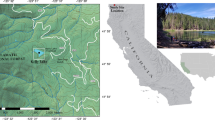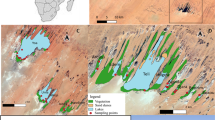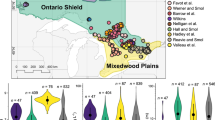Abstract
The diatom composition in surface sediments from 119 northern Swedish lakes was studied to examine the relationship with lake-water pH, alkalinity, and colour. Diatom-based predictive models, using weighted-averaging (WA) regression and calibration, partial least squares (PLS) regression and calibration, and weighted-averaging partial least squares (WA-PLS) regression and calibration, were developed for inferences of water chemistry conditions. The non-linear response between the diatom assemblages and pH and alkalinity was best modelled by weighted-averaging methods. The lowest prediction error for pH was obtained using weighted averaging, with or without tolerance downweighting. For alkalinity there was still some information in the residual structure after extracting the first weighted-averaging component, which resulted in a slight improvement of predictions when using a two component WA-PLS model. The best colour predictions were obtained using a two component PLS model. Principal component analysis (PCA) of the prediction errors, with some characteristics of the training set included as passive variables, was performed to compare the results for the different alkalinity predictive models. The results indicate that calibration techniques utilizing more than one component (PLS and WA-PLS) can improve the predictions for lakes with diatom taxa that have broad tolerances. Furthermore, we show that WA-PLS performs best compared with the other techniques for those lakes that have a high relative abundance of the most dominant taxa and a corresponding low sample heterogeneity.
Similar content being viewed by others
References
Battarbee, R. W., 1984. Diatom analysis and the acidification of lakes. Phil. Trans. r. Soc., Lond. B 305: 451–477.
Battarbee, R. W., J., Mason, I., Renberg & J. F., Talling (eds), 1990. Palaeolimnology and lake acidification. The Royal Society, London, 219 pp.
Bernes, C., 1991. Acidification and liming of Swedish freshwaters. Monitor 12. Swedish Environmental Protection Agency, Solna, 144 pp.
Birks, H. J. B., S., Juggins & J. M., Line, 1990a. Lake surfacewater chemistry reconstructions from palaeolimnological data. In B. J., Mason (ed.), The Surface Waters Acidification Programme. Cambridge Univ. Press, Cambridge: 301–313.
Birks, H. J. B., J. M., Line, S., Juggins, A. C., Stevenson & C. J. F.ter, Braak, 1990b. Diatoms and pH reconstruction. Phil. Trans. r. Soc., Lond. B 327: 263–278.
Borcard, D., P., Legendre & P., Drapeau, 1992. Partialling out the spatial component of ecological variation. Ecology 73: 1045–1055.
Camburn, K. E., J. C. Kingston & D. F. Charles, 1986, PIR-LA Diatom Iconograph. Report Number 3, PIRLA Unpublished Report Series, Bloomington, IN. (53 photographic plates, 1059 figures).
Charles, D. F., 1985. Relationships between surface sediment diatom assemblages and lake water characteristics in Adirondack lakes. Ecology 66: 994–1011.
Dixit, S. S., J. P., Smol, J. C., Kingston & D. F., Charles, 1992. Diatoms: powerful indicators of environmental change. Envir. Sci. Technol. 26: 23–33.
Hill, M. O., 1973. Diversity and eveness: a unifying notation and its consequences. Ecology 54: 427–432.
Hill, M. O. & H. G., Gauch, 1980. Detrended correspondence analysis: an improved ordination technique. Vegetatio 42: 47–58.
Imbrie, J. & T., III, Webb, 1981. Transfer functions: calibrating micropaleontological data in climatic terms. In A., Berger (ed.), Climatic variations and variability: facts and theories. D. Reidel, Dordrecht: 125–134.
Juggins, S. & C. J. F.ter, Braak, 1992. CALIBRATE—a program for species-environment calibration by [weighted-averaging] partial least squares regression. Environmental Change Research Centre, University College, London.
Korsman, T., 1993. Acidification trends in Swedish lakes: an assessment of past water chemistry conditions using lake sediments. Doctoral thesis, Umeå University, Sweden.
Krammer, K. & H., Lange-Bertalot, 1986–91. Süßwasserflora von 093 Mitteleuropa. Bacillariophyceae Band 2/1–4. Gustav Fischer Verlag, Stuttgart.
Line, J. M. & H. J. B., Birks, 1990. WACALIB version 2.1 — a computer program to reconstruct environmental variables from fossil assemblages by weighted averaging. J. Paleolim. 3: 170–173.
Line, J. M., C. J. F.ter, Braak & H. J. B., Birks, 1994. WACALIB version 3.3 — a computer program to reconstruct environmental variables from fossil assemblages by weighted averaging and to derive sample-specific errors of prediction. J. Paleolim. 10: 147–152.
Martens, H. & T., Næs, 1989. Multivariate calibration. John Wiley & Sons, New York, 419 pp.
Munro, M. A. R., A. M., Kreiser, R. W., Battarbee, S., Juggins, A. C., Stevenson, D. S., Anderson, N. J., Anderson, F., Berge, H. J. B., Birks, R. B., Davis, R. J., Flower, S. C., Frits, E. Y., Haworth, V. J., Jones, J. C., Kingston & I., Renberg, 1990. Diatom quality control and data handling. Phil. Trans. r. Soc. Lond. B. 327: 257–261.
Oksanen, J., E., Läärä, P., Huttunen & J., Meriläinen, 1988. Estimation of pH optima and tolerances of diatoms in lake sediments by the methods of weighted averaging, least squares and maximum likelihood, and their use for the prediction of lake acidity. J. Paleolim. 1: 39–49.
Renberg, I., 1990. A procedure for preparing large sets of diatom slides from sediment cores. J. Paleolim. 4: 87–90.
Renberg, I., 1991. The HON-Kajak sediment corer. J. Paleolim. 6: 167–170.
Renberg, I., T., Korsman & N. J., Anderson, 1993a. A temporal perspective of lake acidification in Sweden. Ambio 22: 264–271.
Smith, M. A., 1990. The ecophysiology of epilithic diatom communities of acid lakes in Galloway, southwest Scotland. Phil. Trans. r. Soc. Lond., B. 327: 251–256.
Stevenson, A. C., S., Juggins, H. J. B., Birks, D. S., Anderson, N. J., Anderson, R. W., Battarbee, F., Berge, R. B., Davis, R. J., Flower, E. Y., Haworth, V. J., Jones, J. C., Kingston, A. M., Kreiser, J. M., Line, M. A. R., Munro & I., Renberg, 1991. The Surface Waters Acidification Project Palaeolimnology Programme: modern diatom/lake-water chemistry data-set. ENSIS Publishing, London, 86 pp.
Sullivan, T. J., 1990. Historical changes in surface water acid-base chemistry in response to acidic deposition. Report 11. In NAPAP State of Science and Technology. National Acid Precipitation Assessment Program, Washington, D.C., 181 pp.
Ter Braak, C. J. F., 1987. Unimodal models to relate species to environment. Doctoral thesis, University of Wageningen, 152 pp.
Ter, Braak, C. J. F., 1988. CANOCO — A FORTRAN program for canonical community ordination by [partial] [detrended] [canonical] correspondence analysis, principal components analysis and redundancy analysis (version 2.1). Technical Report LWA-88–02, GLW, Wageningen, 90 pp.
ter, Braak, C. J. F., 1990. Update notes: CANOCO VERSION 3.10. Agricultural Mathematics Group, Wageningen, 35 pp.
Ter, Braak, C. J. F. & I. C., Prentice, 1988. A theory of gradient analysis. Adv. ecol. Res. 18: 271–317.
Ter, Braak, C. J. F. & H.van, Dam, 1989. Inferring pH from diatoms: a comparison of old and new calibration methods. Hydrobiologia 178: 209–223.
Ter, Braak, C. J. F. & S., Juggins, 1993. Weighted averaging partial least squares regression (WA-PLS): an improved method for reconstructing environmental variables from species assemblages. Hydrobiologia 269/270: 485–502.
Ter, Braak, C. J. F., S., Juggins, H. J. B., Birks & H.van der, Voet, 1993. Weighted Averaging Partial Least Squares regression (WA-PLS): definition and comparison with other methods for species-environment calibration. In G. P., Patil & C. R., Rao (eds), Multivariate environmental statistics. Elsevier, Amsterdam: 519–553.
Author information
Authors and Affiliations
Rights and permissions
About this article
Cite this article
Korsman, T., Birks, H.J.B. Diatom-based water chemistry reconstructions from northern Sweden: a comparison of reconstruction techniques. J Paleolimnol 15, 65–77 (1996). https://doi.org/10.1007/BF00176990
Received:
Accepted:
Issue Date:
DOI: https://doi.org/10.1007/BF00176990




